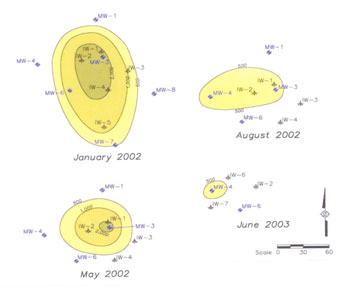|
Successful Remediation of MTBE-Impacted Groundwater using In Situ
Chemical Oxidation with Ozone*
Michael Purchase, Arctos Environmental, Jeffrey M. Baker, P.E., Tesoro Petroleum Companies, Inc., Harry Takach, Ph.D., Orion Environmental Inc., and Jeffrey P. Gwinn, P.E., Orion Environmental Inc.
Description
Initially an SVE/bioventing system was operated for 16 months, removing over 20,800 pounds of gasoline, leaving groundwater concentrations of TPHg and benzene of 60 and 0.37 ppb, respectively. The highest MTBE concentration in September 2001 was 5,400 ppb at a monitoring well just downgradient of the former USTs, with a total estimated area above 500 ppb of over 12,000 square feet. Approximately 5.5 million gallons of groundwater were impacted.
A KTI (formerly KVA) C-Sparge™ in situ chemical oxidation system was chosen, rather than a traditional pump-and-treat system, to complete the remediation for a number of reasons: low operating cost of ozone generation and injection system, proven effectiveness of ozone to treat MTBE in groundwater, harmless byproducts of carbon dioxide and water, capacity of ozone to travel more rapidly in groundwater than oxygen and aggressively break down contaminants.
Five ozone injection wells were installed to 145 feet below grade; two additional injection wells were installed during remediation to address plume deflection caused by ozone injection in the center of the plume.
Results
After a total 20 months of operation injecting less than 0.5 pounds of ozone a day, MTBE concentrations were reduced to 19 ppb. In the center of the plume, MTBE concentrations were reduced from 5,400 to 10 ppb after 9 months of operation, a 99 percent reduction. MTBE concentrations in the cross gradient well initially increased from 120 to 790 ppb, with deflection to the west. However, after 6 months of injection in this area, concentrations were reduced to 12 ppb, a 97 percent reduction. Dissolved oxygen increased by over 4 mg/L in wells 40 feet from injection wells, indicating a radius of influence of 40 feet. Seven months after system shut-down, MTBE concentrations had rebounded to 43 ppb in the groundwater, allowing the regulatory agency to approve site closure.
The total cost, including design, installation, operation, maintenance, and groundwater monitoring, was $263,000, a cost savings of $500,000 and a time savings of 3 to 8 years over pump-and-treat.

*Presented at 2005 NGWA Conference on MTBE and Perchlorate: Assessment, Remediation, and Public Policy, May 26-27, 2005, San Francisco, CA
|